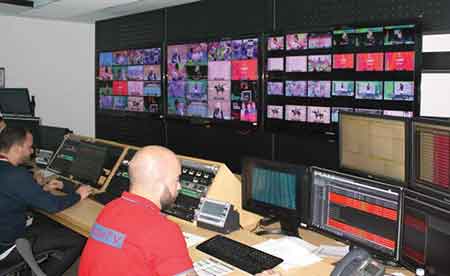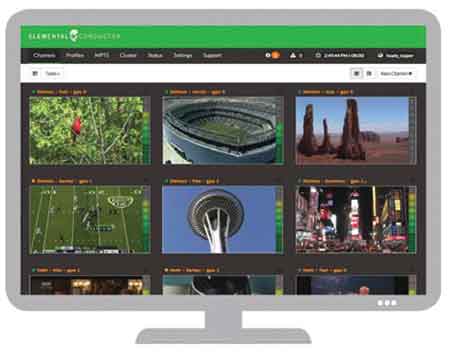Content Anywhere Needs Control, Flexibility

During the Summer Games in Rio, Globosat used Pebble Beach’s Marina platform to build upon the network’s eight-channel capability by adding and controlling eight additional channels through the company’s Marina automation system.SAN FRANCISCO—Back in the day, the primary goal of a multiplatform delivery tools was simple: take control.
Not only have times changed, but even the description of the technology itself has changed, reflecting that technology formerly known as automation—which for so long served as a quiet catalyst for linking together different arms of a broadcast facility—has evolved as well.
Today, new multiplatform delivery technologies are allowing media companies and broadcasters to find new ways to engage audiences who no longer passively consume content in front of their televisions. While managing control room devices remains a key component of these changing multiplatform delivery tools, another key element is the ability to expand playout capacity.
‘ESSENTIAL CONFIDENCE’
During the Summer Games in Rio, the multichannel cable and satellite TV service Globosat used an automation system from Pebble Beach to build upon the network’s eight-channel capability by adding and controlling eight additional channels through the company’s Marina automation system.
On top of channel control, Marina provided OTT feeds and on-demand content of these same channels to viewers.
“[It has] provided us with an essential confidence in our playout solution given the size and complexity of additional infrastructure we are carrying for the Olympic games in Rio,” said Fabrício Faria Santana, a project analyst for Globosat. During the games, Globosat used the Marina system for automated control of ingest and playout, and to handle content workflow management.
Get the TV Tech Newsletter
The professional video industry's #1 source for news, trends and product and tech information. Sign up below.
During the day the system handled sequencing and control of eight of the linear channels as they were receiving live content; at night, Marina controlled the display of reruns and the sequencing of previously transferred material.
According to Luiz Cláudio Costa, a technology development specialist at Globosat, controlling the channel ports with Marina simplified playout chains. “[We were able to] replace them with one single device without giving up on the advantages of our current automation system interface,” he said.
ACCELERATING TIME TO AIR
Tapping into the OTT market was also a priority for Grass Valley with iTX On-Demand, a new video on demand and OTT solution designed to automate the VOD process and reduce prep time for prerecorded and live productions. iTX On-Demand allows for content to be packaged for VOD/OTT use even while a program is being aired live. This gives customers a feature many have been looking for from multiplatform delivery systems: the ability to capitalize on the changing habits of viewers.
“iTX On-Demand specifically addresses nonlinear production in a way that dramatically speeds time to air,” said Mike Cronk, vice president of Core Technology for Grass Valley. “Now users will be able to save money in the production of content and make money in the growing advertising market.” The solution is available as an option with Grass Valley’s iTX Integrated Playout Platform or can be run alongside a third-party playout solution.
Like the automation systems that blazed a path in the industry, iTX On-Demand manages and controls assets. And in terms of outputting content for different mediums, the system controls assets for each VOD work order, which allows for complex tasks to be automatically performed in parallel with linear production workflows, without the need for manual intervention, the company said.
Minimizing manual intervention—and thereby reducing the number of changes that have to be made by hand—was a key factor behind the development of xG Live Log, a module from Imagine Communications designed to connect traffic and playout automation systems. The automated nature of xG Live Log allows a media company to make changes or substitutions within minutes of airtime, and time those logs to avoid awkward transitions. After playout, the system reconciles content updates between the traffic department log and the automation playlist, and pushes that information down the line to accounting.
By improving the link between an automation playlist and the traffic log, incremental edits can be added to a playlist electronically throughout the day, and master control operations are focused on prepping content for playout as opposed to managing the process, the company said.
Reaching new distribution channels was also a priority for U.K. telecommunications company BT, which reaches customers in more than 170 countries. The company moved to standardize on software from Elemental Technologies in an effort to unify its headend to better link together the company’s various services, including BT Sport Ultra HD, a live European sports 4K UHD channel. The goal was to offer more features and functionality to BT TV subscribers via primary screens and multiscreen devices.
The new infrastructure installed by BT leverages Elemental Conductor management software to deliver content to IPTV set-top boxes as well as multiscreen devices. Conductor is designed to reduce the complexity of cluster management and simultaneously scale out for multiple deployments by monitoring and controlling encoding for file-based and live video delivery applications.
For BT, the technology is being used to manage Elemental Live encoder clusters, which are processing channels of standard-and high-definition content, as well as the Elemental Delta video delivery platform to enable live-to-VOD delivery.
According to Elemental, this infrastructure allows BT to scale from 90 to 250 channels and to provide subscribers live, on-demand and time-shift services, such as catch-up TV, restart TV and network PVR.
LINKING DISPARATE SYSTEMS

BT Leverages Elemental Conductor management software to deliver content to IPTV set-top boxes as well as multiscreen devices. Providing content on multiple devices can no longer be just a niche offering. A study conducted just before the start of the 2016 Summer Olympics by the research firm YouGov for Snell Advanced Media (SAM) found that nearly a third of Americans would watch the Games via over-the-top streaming outlets if content was available.
Not only will this demand potentially push broadcasters to adopt new high-resolution technologies and formats such as 4K and HDR content, the study found, it’s also pressing media content providers to set up workflows that link disparate systems together.
Providing the right kind of content to the right place was a priority for the Services Sound and Vision Corp. (SSVC), a British nonprofit that creates and distributes original news programming for Britain’s Armed Forces. Earlier this year, U.K.-based systems integrator dB Broadcast installed an ICE Channel-in-a-Box system with Morpheus automation from Snell Advanced Media at SSVC’s new production and transmission facility. Broadcasting under the banner of the British Forces Broadcasting Service (BFBS), the new SSVC facility includes a playout operation based on four ICE and two ICE LE systems (the more compact automation playout system of the two) that together provides ingest and redundant playout for the network’s 15 TV channels. Using Morpheus automation, the channels are broadcast live to armed forces personnel in more than 23 countries and to British naval ships at sea.
The ICE multichannel playout system allowed the network to enhance its channel offerings, said Quentin Howard, director of technology and television at SSVC. “ICE automation provides BFBS TV with greater flexibility and efficiency to run our complex broadcasting network and unusual workflows,” he said.
Dalet, too, has recognized the necessity of multiplatform distribution, and the company’s Dalet Galaxy media asset management platform is designed to allow multiple departments to collaborate and distribute programming across multiple platforms.
Galaxy centralizes content, planning, production and archive management, helping media companies streamline creation, publishing and playout to both traditional channels and online and social media outlets.
Nowhere is this truer than in the newsroom where Dalet Galaxy enables staff to share stories between TV, radio and web news departments by organizing content into a centralized database and production tools under a single platform.
Taking advantage of those options was one of the reasons Australian public broadcaster Special Broadcasting Service Corp. (SBS) began to streamline its media operations on Galaxy. SBS decided to tie together dozens of different workflows and integrate 10 different systems with the Galaxy, allowing SBS to pull archives into the production workflow and provide tools that will allow the broadcaster to facilitate new media workflows from a single system.
A ‘CUSTOMIZED MULTISCREEN EXPERIENCE’
The same drivers—multiscreen viewing options—are being made possible with a series of multimedia distribution systems from EVS, such as the EVS C-Cast Multimedia Distribution platform, which takes recorded content from an EVS server and enables content companies to create a customized, multiscreen experience. The system enables instant distribution of multiple camera angle content to Web-connected screens during live productions, which have proven to be a good fit for sports and live events.
Japanese sports media company Dentsu deployed C-Cast to implement a second-screen service to complement its traditional broadcasting of Olympic volleyball qualification matches. Powered by C-Cast, the company’s VOLLEYBALL EyeSurround enabled viewers to access companion content alongside to the main live broadcast, including clips from multiple camera angles.
With C-Cast, Dentsu can deliver an enhanced, interactive viewing experience by taking advantage of multiple cameras and hours of footage that often is not aired, according to Teppei Yasubuchi, project manager for Dentsu. “Viewers can replay the action their way,” he said. “They decide what they watch, when they watch it, and from which camera angle.”
Integrated into its existing live broadcast production infrastructure, C-Cast allows Dentsu to deliver short clips from multiple viewing angles. The VOLLEYBALL EyeSurround app also allows viewers to watch live streaming of matches.
“C-Cast enables them to use content they already have, which would otherwise go to waste, to deliver premium content, increase viewer engagement and create new revenue streams,” said Olivier Heurteaux, general sales manager, EVS. “The technology is allowing media companies and broadcasters to find new ways to engage audiences who no longer sit passively in front of their televisions.”
Susan Ashworth is the former editor of TV Technology. In addition to her work covering the broadcast television industry, she has served as editor of two housing finance magazines and written about topics as varied as education, radio, chess, music and sports. Outside of her life as a writer, she recently served as president of a local nonprofit organization supporting girls in baseball.

